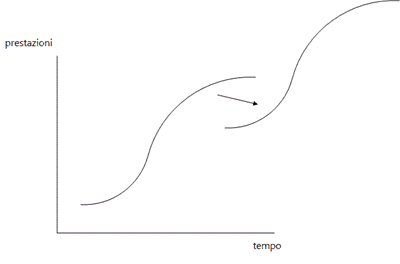Introduction
POS (Point of Sale) software, especially in chains, is considered a competitive factor and thus highly customized in order to differentiate from competition. Unfortunately, this long process is gradually becoming less effective in following the needs of a “connected” society.
For independent retailers, customized legacy IT is less relevant, but Cloud Computing and Software as a Service (SaaS) brings also to them the dilemma between tradition and innovation.
The innovation cycle
New technologies and architectures emerge to satisfy new market needs and lifestyles. When the latter change, the first becomes less appropriate to give optimum responses. Sooner or later comes the time to restart from new basis and with new visions.
Every innovation in the initial phase struggles to impose itself to human inertia toward new ideas and investments. When the benefits are well established and technicians had time to “digest” the new ideas, starts the “new normal” phase with a general race to catch up. Then follows a phase of gradual obsolescence where the context has changed again and the current technologies and architectures are no longer suited to give effective answers. In this situation, innovators make the leap to new technologies and start a completely new cycle.

We should make clear that innovation means a paradigm shift: a new vision and not just a refinement of the current practices. In the building field, for example, reinforced concrete and later steel / glass created new architectures giving responses to new needs. A builder using new technologies in old architectures or viceversa, will produces mediocre results in all means.
Going back to Retail, Cloud native SaaS for POS and Back Store operations impose a restart from new foundations, especially for software developers. It is easy to use Cloud Computing for hosting legacy applications, but avoiding the effort of a paradigm shift will produce limited results in the short term and none in the medium.
Now Cloud Computing is almost at the “new normal” stage and the move from legacy IT is no longer a question of “if” but only of “when”. The problem is to distinguish solutions specifically designed for the Cloud from “Cloud washing” (exterior modifications dictated more by marketing than by technical reasons) or SoSaaS (Same old software as a service) that give the apparent advantage of continuity, but will have short life because they don’t face the new environment with the necessary effectiveness.
Jump or wait?
The initial phase of any innovation brings inevitably more risk than in the maturity and obsolescence phase, because it is not yet fully understood by the whole ecosystem. But, as it happens in all human activities, the investment return is proportional to the risk level.
Innovating before competitors, not only creates real competitive advantages, but it also produces lower operating costs and / or increased revenues for a longer period. Moreover, current times imposes a cost control much greater than in the past and also greater environmental responsibility.
There is also an image advantage that benefits only early adopters. Although intangible, it brings high monetary value when compared with the cost of a place in the consumer mind achieved through traditional marketing techniques.
Many IT managers are “locked” by heavily customized legacy systems. Rebuilding them as-is in a Cloud native environment can be extremely costly, if not impossible, and in any case it is the wrong way to go. For example, one of the essential Cloud Computing characteristic is multi-tenancy (the sharing of the same hardware and software by different companies). Among many benefits on cost, quality and efficiency, it also replace the long and expensive customizations with fast and simple configurations. Of course, the configuration predetermined freedom can be a limitation for someone, but a strong competitive advantage of the new IT based on Cloud native services is integrating them like Lego blocks, creating tailored systems from composition. The new role of Chief Information Officers will be to select and integrate the Cloud services more suited to the company business model and development strategy.
Cloud Computing can be avoided?
The Cloud Computing efficiency and agility is already at a level not possible with traditional IT. The most discussed topics are currently Big Data, Machine Learning, Predictive Analytics and IoT (Internet of Things) and will certainly have a strong impact on Retail, but these technologies have technical and economic sense only on the Cloud. So the answer is: No, in medium/long term Cloud Computing can’t be avoided.
Unfortunately, the software redesign in order to exploit the full potential of this new paradigm requires time and very substantial investment that cannot happen with a “big bang” but gradually integrating legacy sub-systems with new Cloud native SaaS, defined also “Hybrid Cloud”. The result will be the gradual disappearance of legacy systems.
Efficiency often receives more attention than agility, but it should be the opposite. In a period of rapid changes, the ability to adjust IT quickly and relatively painlessly by replacing a legacy subsystem with a SaaS or a SaaS with a new SaaS, has a strategic value. A completely new feature, if delivered as a Clud native SaaS, can be tested in some stores quickly and cheaply. If the result is positive, the deployment in the entire chain can be nearly immediate.SaaS, can be tested in some stores quickly and cheaply. If the result is positive, the deployment in the entire chain can be nearly immediate.
What happens in the living species where not the strongest, but the most adaptable to environmental changes survive, also applies to companies.What happens in the living species where not the strongest, but the most adaptable to environmental changes survive, also applies to companies.
Archivio
35010 Vigonza (PD)
P.IVA/C.F: 02110950264
REA 458897 Cap.soc. 50.000€
Software
Blog
© Copyright 2023 aKite srl – Privacy policy | Cookie policy